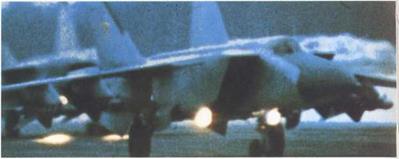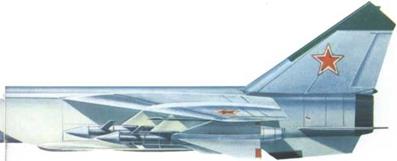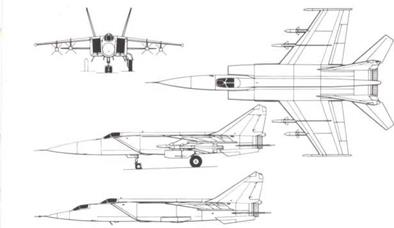Mikoyan/Gurevich MiG-25
Mig-25 ("Foxbat A"), -25R and -25U
Origin: The design bureau named for Mikoyan and Gurevich, Soviet Union. Type: "Foxbat A" (believed to be MiG-25S), all-weather long-range interceptor: MiG-25R, reconnaissance: MiG-25U, tandem-seat dual
trainer with stepped cockpits.
Engines: Two Tumansky R-31 afterburning turbojets each rated at 27,000lb (12,250kg) with full augmentation.
Dimensions: Span 46ft (14-0m): length ("A”) 73ft 2in (22-3m). (R)
74ft 6in (22-7m), (U) about 76ft (23■ 1 6m): height 18ft 6in (5 63m). Weights: (Fighter) empty 44,000lb (19,960kg): normal loaded 68,350lb (31,000kg): maximum loaded with external missiles or tanks 79,800lb (36,200kg).
Performance: (Estimated) maximum speed at altitude 2,1 OOmph
(3380km/h. Mach 3-2): initial climb, about 50,000ft (15,240m)/min: service ceiling 73,000ft (22,250m): high-altitude combat radius without external fuel, 700 miles (1130km).
Armament: (" A") four underwing pylons each carrying one AA-6 air-to – air missile (two radar, two infra-red) or other store: no guns: ("-B") none. History: First flight (E-266 prototype) probably 1964: (production reconnaissance version) before 1969: (production interceptor) probably 1969: service delivery (both) 1970 or earlier.
Users: Algeria. Libya, Soviet Union.
 |
Development: This large and powerful aircraft set a totally new level in combat-aircraft performance. The prototypes blazed a trail of world records in 1965-67 including closed-circuit speeds, payload-to-height and rate of climb records. The impact of what NATO quickly christened "Foxbat" was unprecedented. Especially in the Pentagon, Western policymakers recognised that here was a combat aircraft that outclassed everything else, and urgent studies were put in hand for a new US Air Force fighter (F-15 Eagle) to counter it. By 1971 at least two pairs of reconnaissance aircraft were flying with impunity over Israel, too high and fast for Phantoms to catch, while others have made overflights deep into Iran. This version is different in many respects, the nose having cameras instead of a "Fox Fire" radar, and other sensors being carried under the large body. Both versions have twin outward-sloping vertical tails, single mainwheels and a flush canopy
 Above: Night takeoff by a section of MiG – 25 ‘Foxbat-A’ all – weather interceptors.
Above: Night takeoff by a section of MiG – 25 ‘Foxbat-A’ all – weather interceptors.
Above: Three-view of MiG-25 ("Foxbat A") with side view (bottom) of -25U.
shaped for speed rather than pilot view. From the start the main development effort has been applied to the basic MiG-25 (so-called "Foxbat A") interceptor, which has been developed in structure, systems and armament since first entering service with the PVO. In 1 975 the original AA-5 missiles were supplemented, and later replaced, by the monster AA-6 "Acrid”, which is easily the biggest air/air missile in service in the world. The radar-homing version has a length of about 20ft 2in (6-1 5m) and effective range of 28 miles (45km): the infra-red missiles have a length of just over "19ft (5-8m) and range of some 12-5 miles (20km). Another major improvement since entering service is flight-refuelling capability, not yet fitted to all MiG-25 versions. The detailed inspection of an interceptor version landed at Hakodate AB, Japan, on 6 September 1976, showed that in service pilots are forbidden to use the limits of the available flight performance, presumably to avoid thermal fatigue of the airframe: it also showed this particular machine to have early "Fox Fire" radar comparable in basic technology with the AWG-10 Phantom radar (as would be expected). Radars in current production are unquestionably solid-state pulse-doppler types able to look down and track low-flying aircraft against ground clutter. Several MiG-25s. most of them MiG-25R models on ELINT missions, have been plotted by Western radars at Mach 2-8. It should be emphasized that at this speed the MiG-25 – and any other aircraft – flies in a straight line. The MiG-25 was not designed for air combat, and if it became involved in a dogfight its speed would – like any other aircraft — soon be subsonic. The MiG-25U trainer carries neither weapons nor sensors, but is needed to convert pilots to what is still, 15 years after design, a very advanced and demanding aircraft.

![]()

Below: Artist’s impression of the basic ‘Foxbat-A’ interceptor version of MiG-25, essentially similar to the aircraft in which Lt Belenko defected to Japan in 1976.










